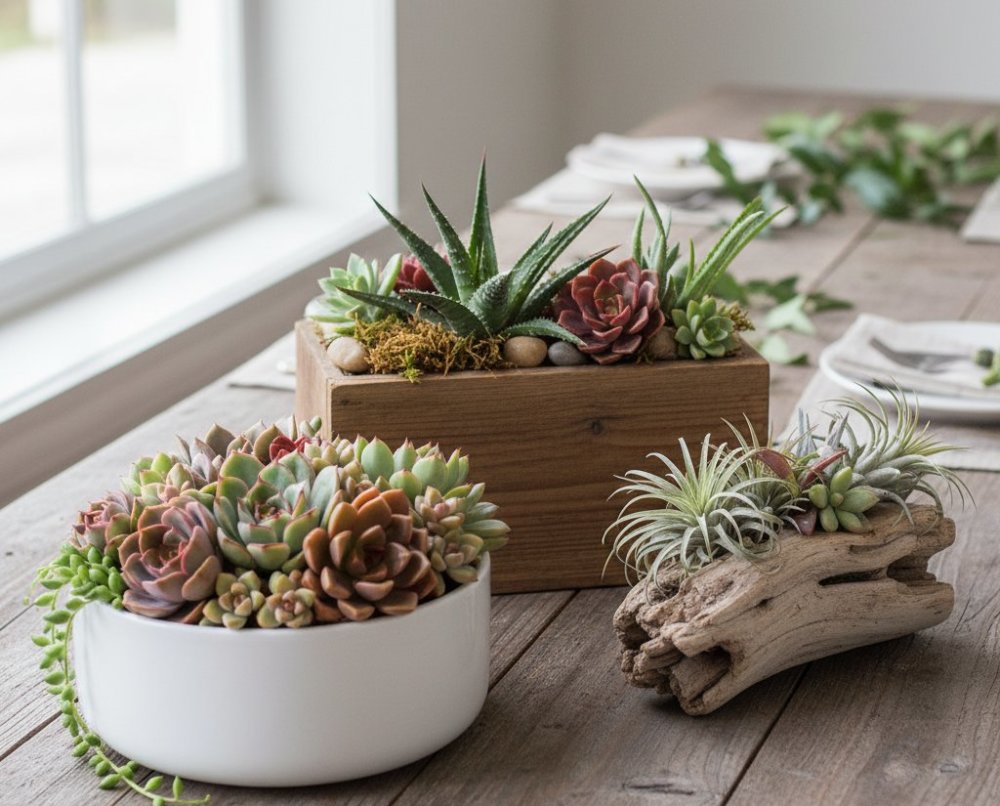Succulent Centerpieces Ideas
Succulent centerpieces bring a natural and modern touch to any table without demanding much upkeep. They work well for casual gatherings, weddings, or even everyday home décor. A succulent centerpiece gives you a stylish, low-maintenance way to add greenery and texture to your space.
You can choose from many styles, from sleek ceramic bowls filled with mixed succulents to rustic wooden planters or even driftwood arrangements. Each option creates a different mood, whether you want something simple and clean or more earthy and organic.
As you explore different types, design ideas, and easy ways to create your own, you’ll see how versatile these arrangements can be. Whether you want a centerpiece for a special occasion or a piece you can keep on your table year-round, succulents offer a practical and attractive solution.
Types of Succulent Centerpieces
Succulent centerpieces can look very different depending on how you arrange them. Some focus only on the unique shapes and colors of succulents, while others combine them with flowers for more variety and contrast.
Living Succulent Arrangements
Living succulent arrangements use real plants that continue to grow over time. You often see them in shallow bowls, wooden boxes, or driftwood planters. These designs highlight the natural textures and colors of succulents, from soft green rosettes to red-tipped leaves.
You need well-draining soil and containers with drainage holes to keep the plants healthy. Succulents such as echeveria, jade, and haworthia work well because they stay compact and adapt to indoor or outdoor tables.
A living arrangement can last for months with proper care. You only need to water sparingly, usually once the soil has dried out. Placing the centerpiece in bright, indirect light helps the plants stay vibrant without burning the leaves.
Many people choose these arrangements for long-term décor because you can replant or trim the succulents as they grow. This makes them practical and sustainable compared to cut flowers that fade quickly.
Mixed Succulent and Flower Combinations
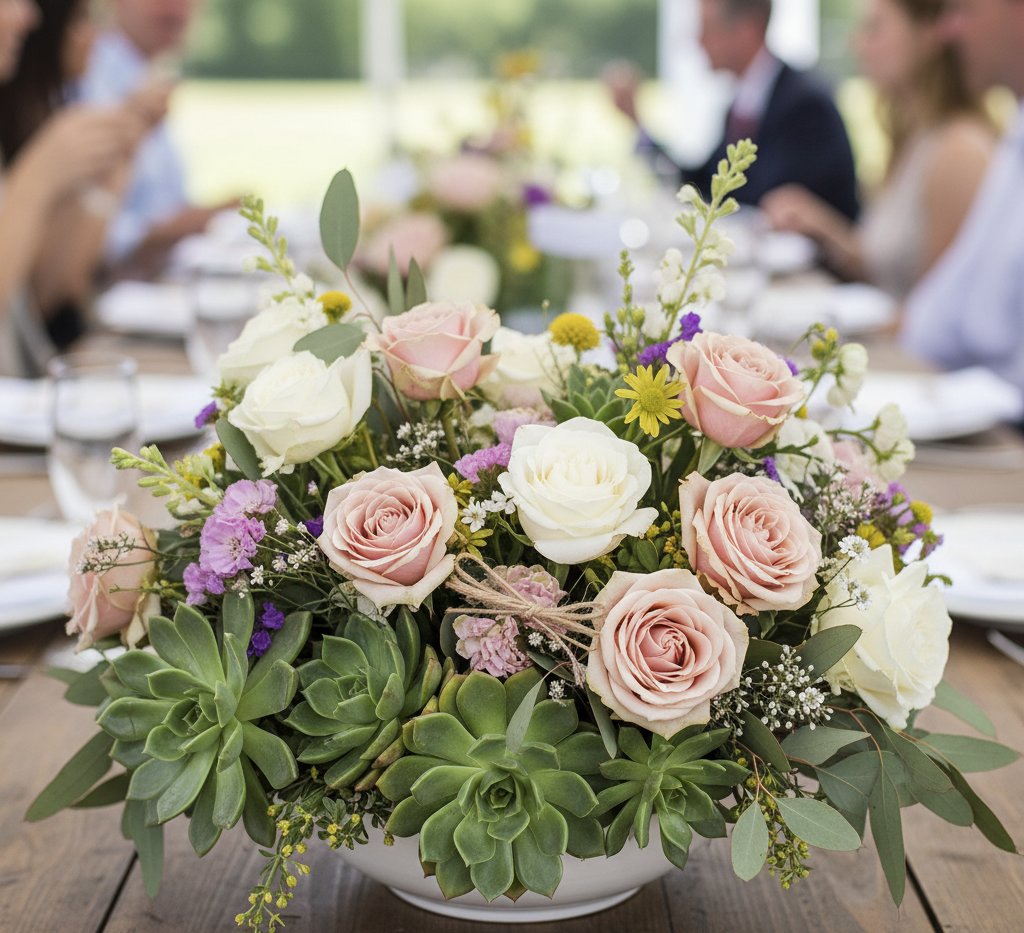
Mixed centerpieces combine succulents with cut or dried flowers to create more color and texture. The sturdy leaves of succulents contrast with the softer petals of flowers, making the arrangement stand out on a table.
Common pairings include succulents with roses, wildflowers, or baby’s breath. These combinations work well for weddings, showers, or seasonal displays. The flowers add height and brightness, while the succulents provide structure and long-lasting greenery.
You can place these mixes in ceramic vases, wooden trays, or glass bowls. Some designs use fresh flowers for a short-term display, while others use dried or preserved blooms for longer use.
This type of arrangement gives you flexibility. You can swap flowers to match a season or event theme while keeping the succulents as a steady base. The mix offers a balance of durability and variety that works for both casual and formal settings.
Design Ideas and Inspirations
You can shape succulent centerpieces to match different settings by choosing containers, accents, and layouts that highlight their unique textures. Simple designs work well for modern spaces, while natural materials and seasonal touches let you adapt them for rustic or holiday themes.
Modern and Minimalist Styles
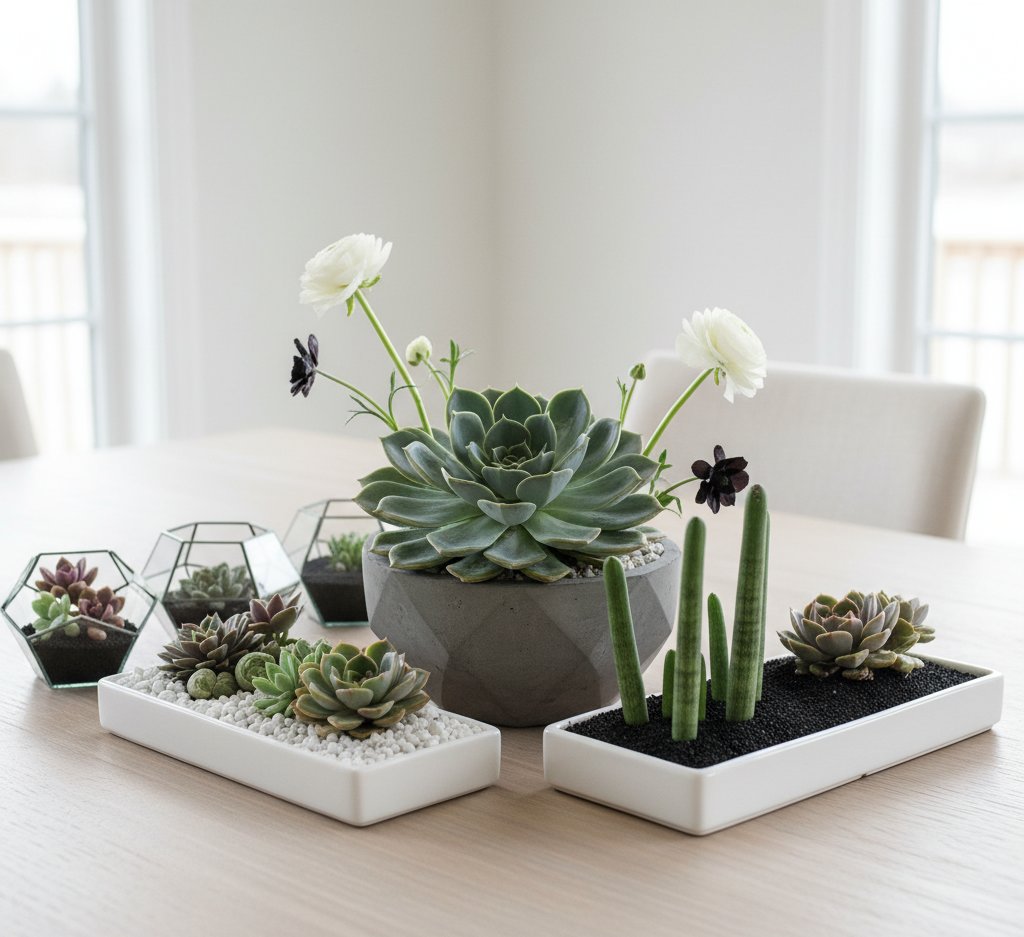
For a clean look, place succulents in geometric planters made of concrete, glass, or ceramic. Neutral colors like white, gray, or black keep the focus on the plants’ natural shapes. Low-profile bowls or rectangular trays also create a streamlined effect.
You can use a single large rosette succulent as a focal point, then surround it with smaller plants for balance. Adding white gravel or black sand around the base makes the arrangement feel polished.
If you want a living centerpiece that doesn’t overwhelm the table, try grouping three small pots in a row. This works well for dining tables where space is limited. You might also mix in a few cut flowers for contrast, but keep the palette simple to maintain the minimalist style.
Rustic and Natural Themes
Rustic designs highlight natural textures and earthy tones. You can arrange succulents in wooden boxes, driftwood planters, or terracotta pots. These materials pair well with the muted greens and soft purples of many succulent varieties.
Layering preserved moss, stones, or bark chips helps create a natural base. You can also display them with small potted herbs or flowers nearby for added color and scent. A wooden tray filled with grouped plants can serve as a centerpiece for a farmhouse table.
For outdoor events, use repurposed containers like berry bowls or metal tins. This adds character while keeping the design casual. If you want height, include a taller plant such as a snake plant or aloe in the center, then surround it with low-growing succulents.
Seasonal and Holiday Centerpieces
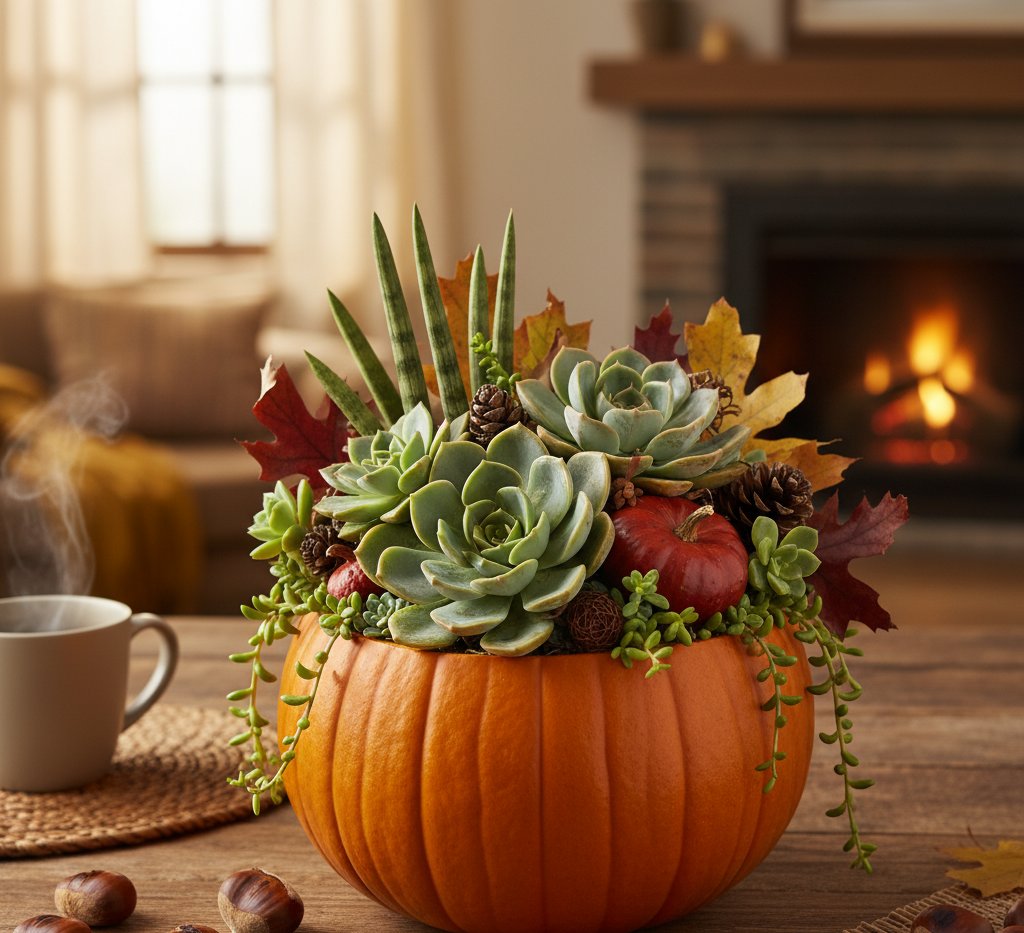
Succulent centerpieces adapt well to different times of year. In fall, you can hollow out a pumpkin and use it as a planter. The mix of orange tones with green succulents creates a seasonal display that feels warm and festive.
For winter, pair succulents with pinecones, evergreen branches, or even a small mylar balloon for a playful touch. A shallow bowl filled with white stones and frosty-hued plants like echeveria gives a wintry look without being too heavy.
During spring and summer, add bright flowers such as daisies or ranunculus alongside succulents for a fresh, colorful centerpiece. Glass vases or clear bowls highlight the layers of soil, rocks, and plants, making the arrangement feel light and airy.
You can also adapt these ideas for holidays like Easter or Christmas by adding small ornaments, candles, or themed accents while keeping the succulents as the main feature.
How to Create Succulent Centerpieces
You can make a lasting arrangement by picking hardy succulents, pairing them with the right container, and layering materials that keep roots healthy. A simple step-by-step process helps you build a centerpiece that looks clean and stays low-maintenance.
Choosing the Right Succulents and Plants
Select succulents that grow well indoors and require little water. Popular choices include Echeveria, Aloe, and Haworthia. These plants have thick leaves that store water, which makes them easy to care for.
Mix plants with different shapes and colors to add variety. For example, combine a rosette-style succulent with trailing varieties like String of Pearls. For texture, use decorative gravel or dried/preserved moss, but strictly avoid plants that need frequent watering as they won’t thrive with low-moisture succulents.
When choosing sizes, balance tall and short plants. Place taller succulents in the center or back of the arrangement and smaller ones around the edges. This layout creates a natural, layered look that works well on tables.
Selecting Containers and Materials
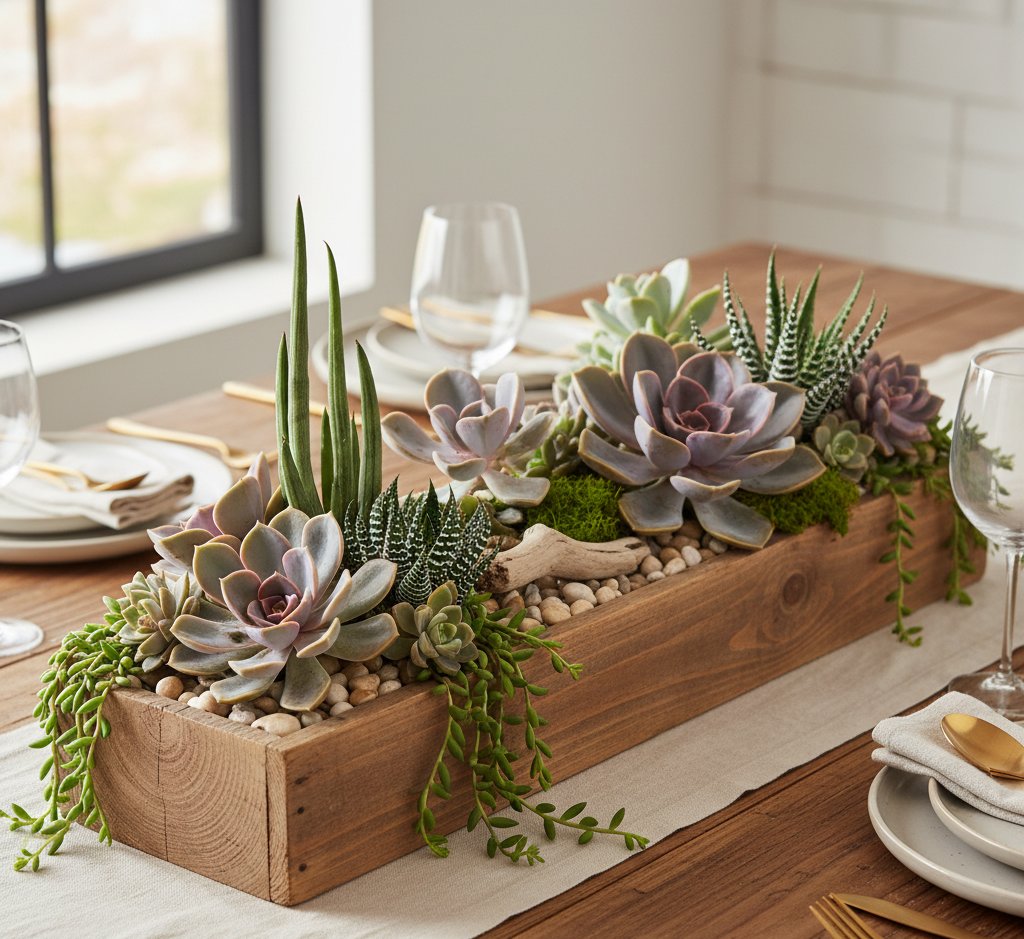
Pick a container that fits your style and space. Bowls, wooden boxes, glass vessels, or even driftwood pieces all work well. Ideally, the container should have a drainage hole. If it doesn’t, ensure you water sparingly to prevent saturation.
You need a few basic materials:
- Succulent soil (well-draining mix)
- Activated charcoal (optional, for containers without drainage to help keep the soil fresh)
- Decorative top layer such as gravel, sand, or preserved moss
The container’s color and shape should complement the plants. Neutral tones highlight the greenery, while bright or patterned containers can make the centerpiece stand out.
Step-by-Step Assembly Guide
- Prepare the base. Ensure the container has drainage holes for water to escape.
- Add soil. Fill with succulent-friendly, fast-draining soil, leaving enough space for roots.
- Position plants. Start with the largest succulent, then add medium and trailing plants. Space them so leaves don’t overlap too much.
- Fill gaps. Add more soil to secure the roots, then press gently.
- Top layer. Spread decorative gravel, sand, or preserved moss to cover the soil and give a clean finish.
- Water lightly. Use a small amount of water to settle the soil, but avoid soaking.
This process creates a stable environment for your plants and keeps the arrangement neat for display.
Occasions and Uses for Succulent Centerpieces
You can use succulent centerpieces in many settings where durability, low care, and simple style matter. They work well for formal gatherings, casual home spaces, and even as thoughtful gifts that last longer than cut flowers.
Weddings and Special Events
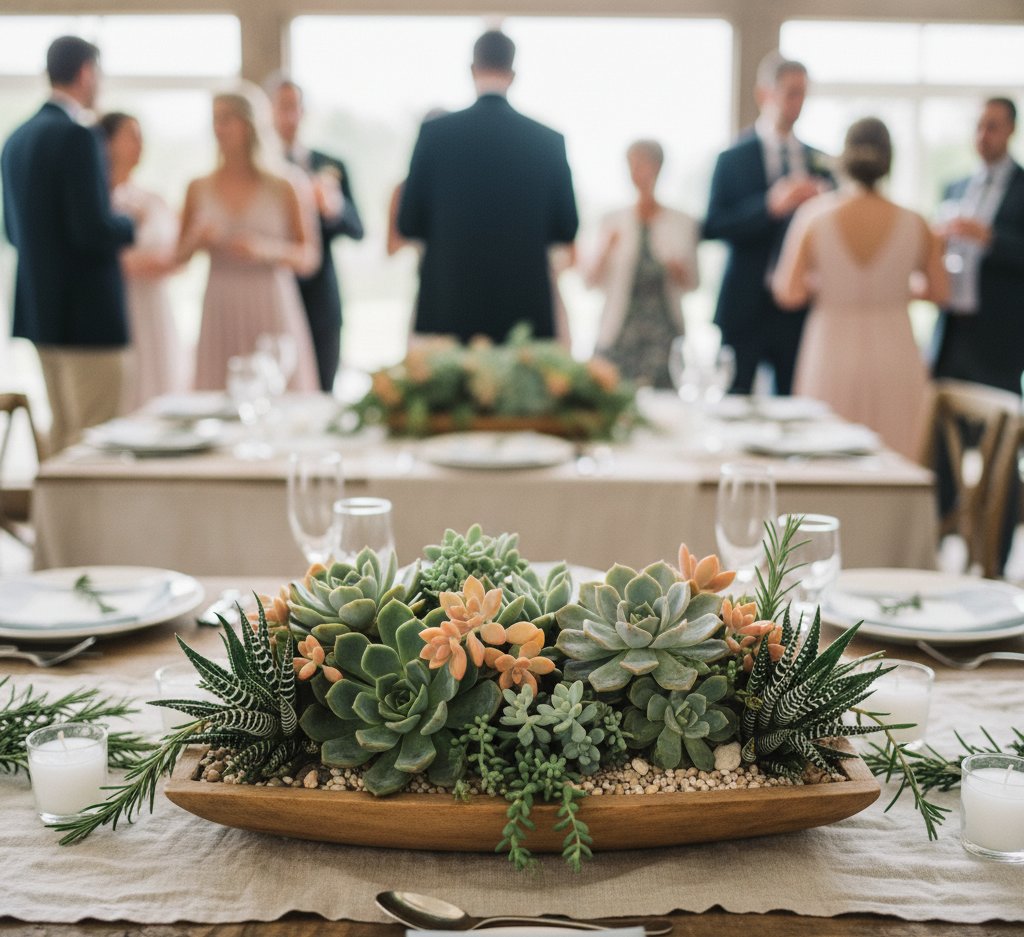
Succulent centerpieces give you a fresh option for weddings, showers, and milestone parties. Unlike cut flowers that wilt within hours, succulents hold their shape and color through the day and beyond. This makes them practical for long events where you want tables to stay attractive.
You can mix succulents with cut flowers to add variety in color and texture. For example, rosette succulents pair well with roses or dahlias in neutral or pastel palettes. Adding candles or small mylar balloons can create a festive look without overwhelming the arrangement.
Succulent centerpieces also fit well with rustic or outdoor venues. A wooden planter box filled with mixed succulents can serve as both a centerpiece and a keepsake for guests. Because they require little water, they stay neat even in warm weather.
Home Decor and Everyday Use
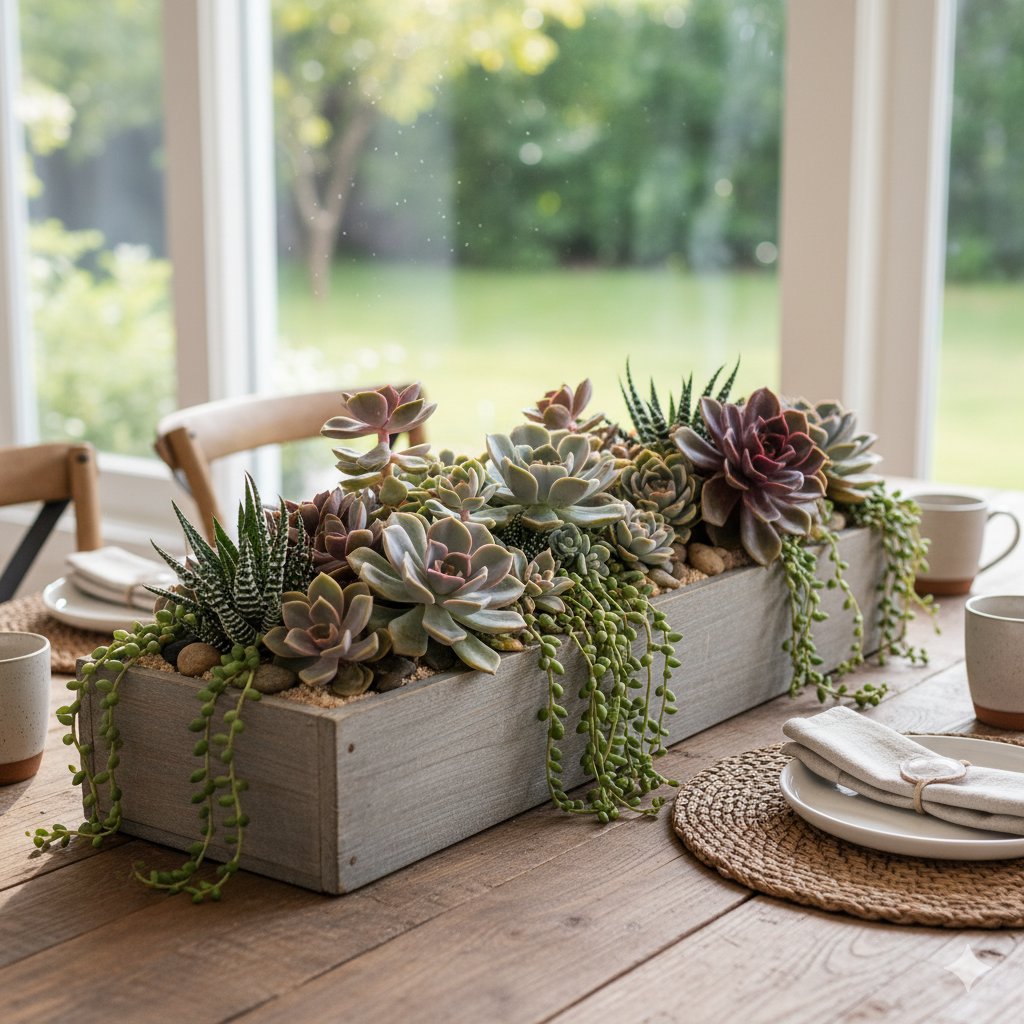
At home, you can use succulent centerpieces to brighten dining tables, coffee tables, or kitchen counters. Their compact size makes them easy to place in small spaces, while their variety of shapes and colors adds interest without clutter.
Succulents thrive in containers like ceramic bowls, glass terrariums, or even repurposed wood boxes. Unlike traditional flowers, they don’t need frequent replacement, making them a low-maintenance option for everyday decor.
You can change the arrangement with the seasons. For example:
- Spring: Add small wildflowers for color.
- Fall: Pair with pumpkins or dried leaves.
- Winter: Use pinecones or simple candles for a clean look.
This flexibility makes succulent centerpieces a reliable choice for year-round decorating.
Gifting and Personalization Options
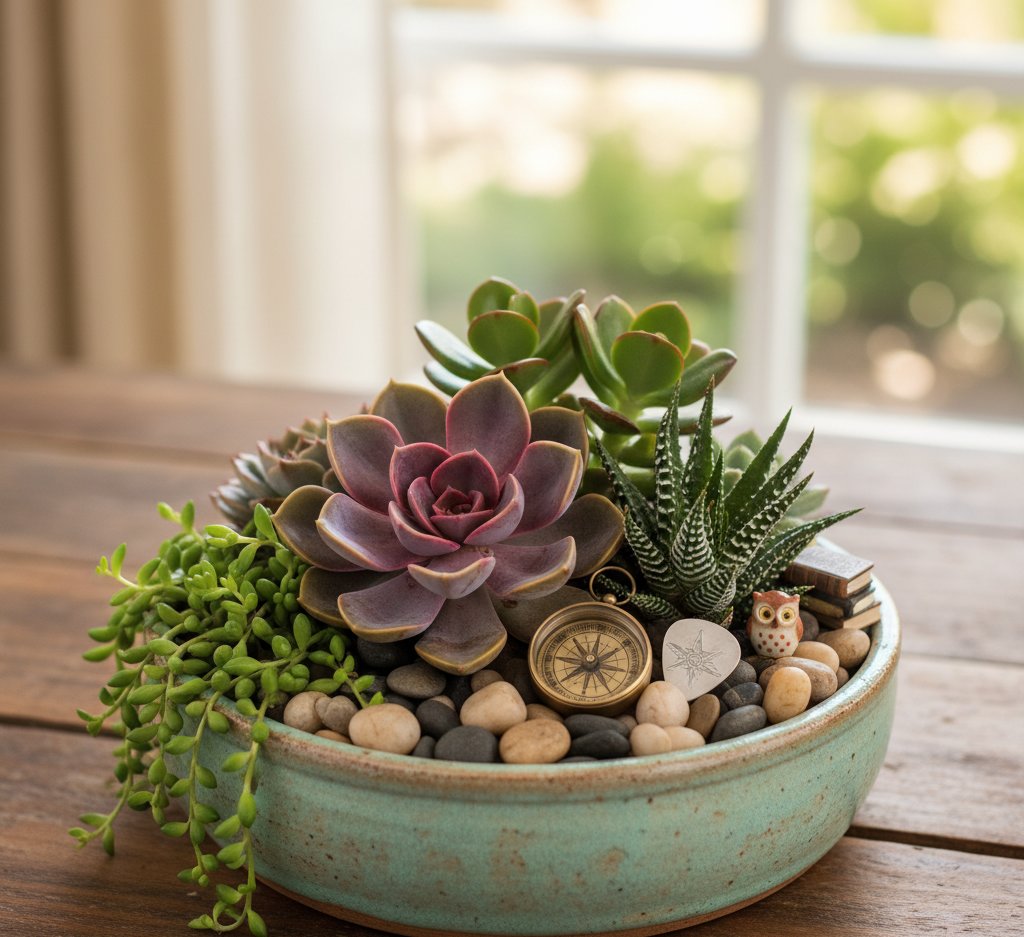
Succulent centerpieces also work well as gifts. Because they last for months with minimal care, they provide more value than cut flowers or balloons alone. You can personalize them with containers, decorative stones, or even small items that reflect the recipient’s style.
For birthdays, you might combine succulents in a bright pot with a small mylar balloon. For housewarmings, a neutral wooden box filled with mixed succulents makes a practical and stylish gift.
You can also create themed sets. A trio of small succulent centerpieces in matching pots can work as a group gift or be split among friends. Since succulents are easy to replant, the recipient can expand their collection over time.

